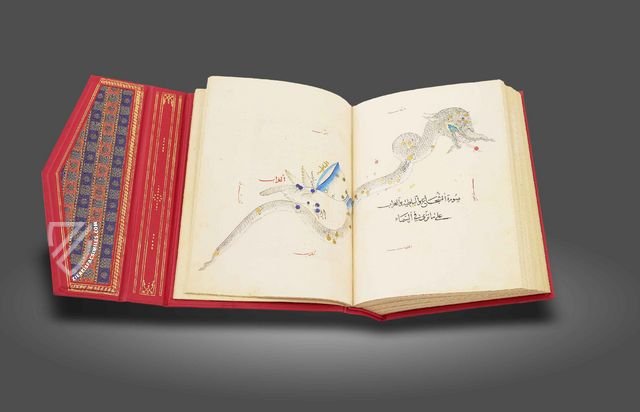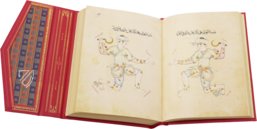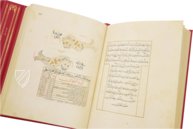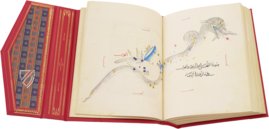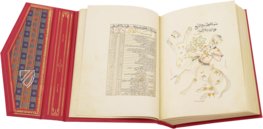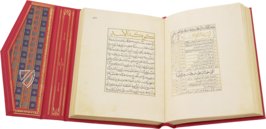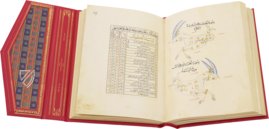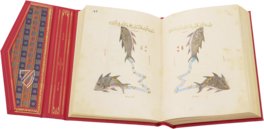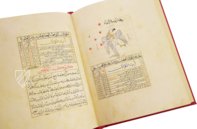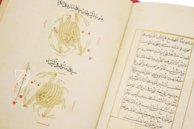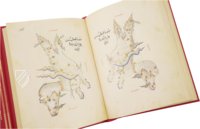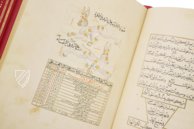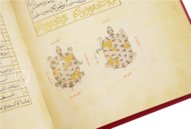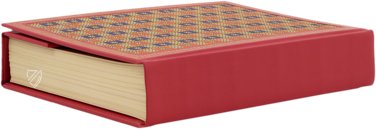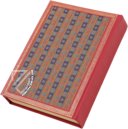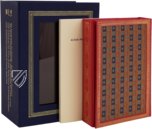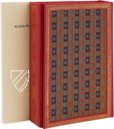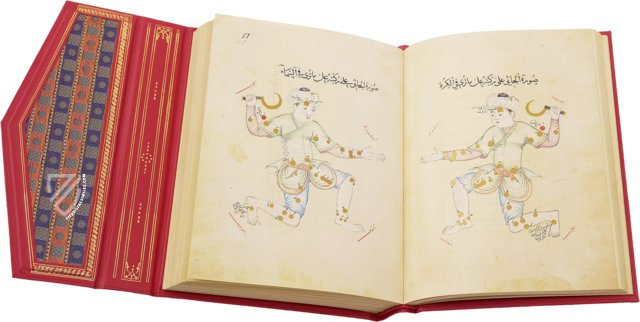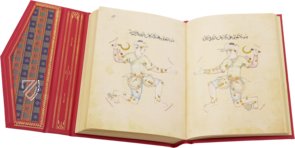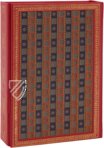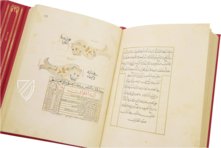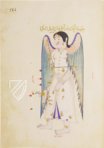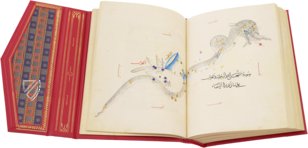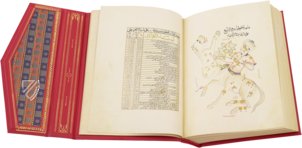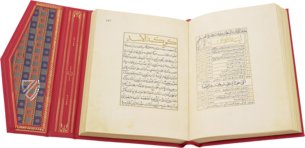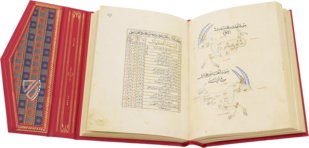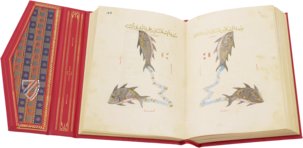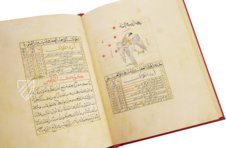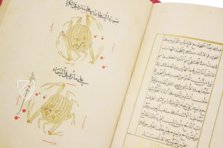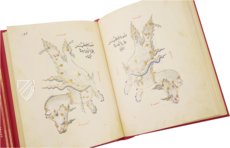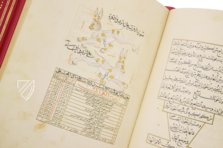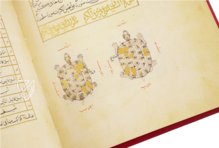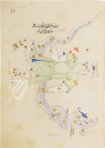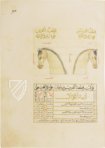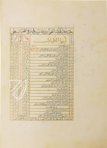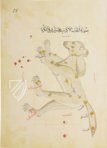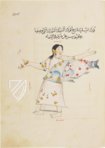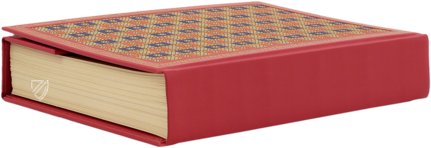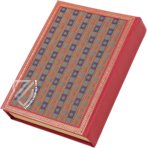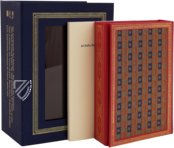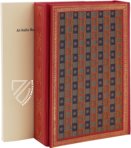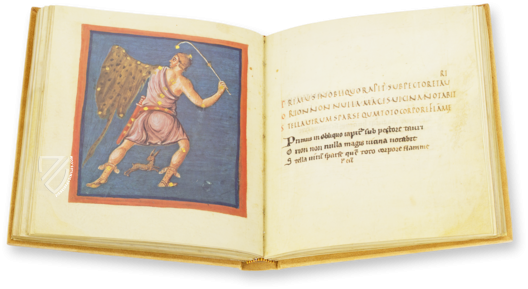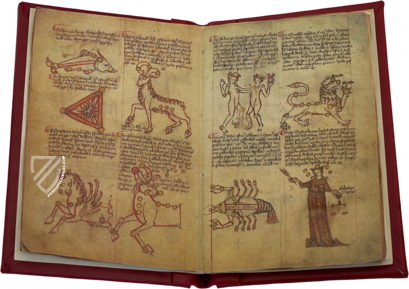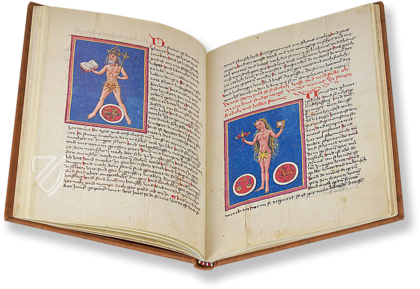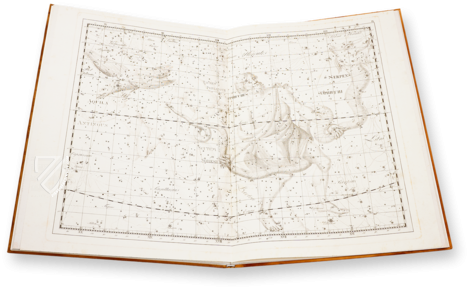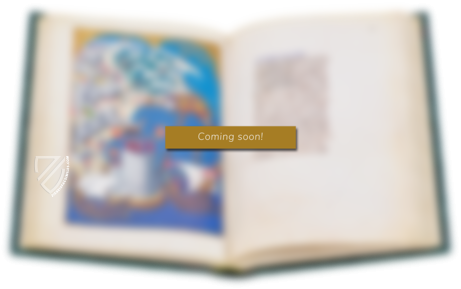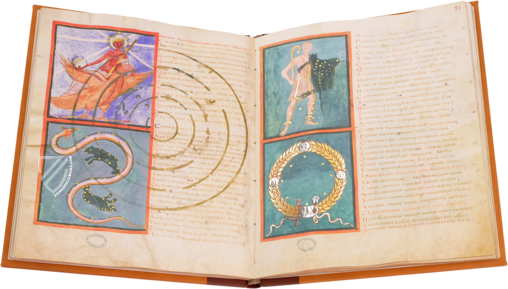Ulugh Beg's Book of the Constellations
(3,000€ - 7,000€)
Ulugh Beg was not only the governor of Samarkand, but also an idealistic patron and financier of science and the arts, and a gifted mathematician and astronomer himself. As such, he had the Book of the Constellations copied and magnificently illuminated for his own use between 1430 and 1440. The basis for this impressively accurate star catalogue is an astronomical treatise from the 10th century, which was intended to assist the prince in his own observations of the heavens. The influential and calligraphically unsurpassable text is complemented by 74 enchanting, often full-page miniatures of the star constellations described. In the delicately drawn, pastel-coloured miniatures, the individual stars shine in brilliant gold and are sized according to their brightness. Stars that do not belong to the constellation are shown in red,and all are identified by name with the help of inscriptions. This masterpiece of Central Asian art is without doubt one of the most beautiful manuscripts on the night sky and demonstrates a breathtaking interplay of scientific knowledge and artistic sophistication!
A splendid astronomical manuscript for the palace library
Astronomy is one of the oldest sciences in human history. The Timurid prince Ulug Beg (1394–1449) also seems to have had the desire to fathom the universe and the role of the Earth in it. It was clear to him that this would require a precise star catalog as a basis, which is why he had the Book of the Constellations copied and magnificently illuminated at his court in Samarkand between ca. 1430 and 1440.
A passionate scientist on the throne
Ulug Beg led astronomy to a new heyday in the 15th century during his rule over Samarkand. He was not only a patron and financier of science and the arts, but also a gifted mathematician and astronomer himself. Thus, it is not surprising that he had the famous observatory built, which at that time was ranked as the best observatory in the world and enabled incredibly accurate observations of the sky. For example, Ulug Beg and his scholars managed to calculate the stellar year to an accuracy of 58 seconds.
His fascination with science is evident from an early age: Only shortly after his grandfather, the Timurid ruler Timurlengs, appointed him governor of Samarkand at the age of 15, he founded a university in the legendary city on the Silk Road and thereby gathered numerous scholars at his court, with whom he jointly pursued science.
Für Jahrhunderte unübertroffene Präzision
The Book of the Constellations is a copy of the remarkable astronomical treatise and star catalog by the Persian scholar Al-Sufi (903–986). Back in the 10th century, he succeeded in combining the findings of Ptolemy's (100–160) Almagest with Arabic literature and his own observations to create a work that was unsurpassed in precision for centuries and soon became the standard in both the Islamic and Christian worlds. In it, Al-Sufi even described the Magellanic Cloud and the Andromeda Galaxy.
Astronomische Konstellationen in atemberaubenden Miniaturen
The constellations and celestial bodies described in the calligraphically refined text are illuminated in this magnificent copy of Al-Sufi's work with 74 enchanting, often full-page miniatures, which not only have aesthetic value, but are also useful for scientific observation of the sky. All constellations are shown in duplicate: once as they can be seen in the sky from Earth, and once the other way around as a projection onto a sphere, as if viewed from space.
In the delicately drawn, pastel-colored miniatures, which show some influences from Chinese art, the individual stars shine in brilliant gold, their size being based on their brightness. Meanwhile, those stars that do not belong to the respective constellation appear in red, though all are identified by inscriptions with their names. A breathtaking interplay of scientific knowledge and artistic sophistication!
Codicology
- Alternative Titles
- Ulug Begs Buch der Fixsterne
Die Astronomie des Prinzen – Das Buch der Fixsterne (Ulugh Beg)
Book of the Constellations of the Fixed Stars
Book of Fixed Stars
The Stars of Samarkand
Kitāb suwar al-kawākib al-tābita - Type
- Manuscript on paper
- Size / Format
- 494 pages / 24.5 × 18.5 cm
- Origin
- Uzbekistan
- Date
- Ca. 1430–1440
- Epochs
- Style
- Genre
- Language
- Script
- Naskh script
- Illustrations
- 93 large illustrations of the constellations, two of them double-page and many full-page
- Content
- Kitāb suwar al-kawākib al-tābita by al-Sūfī
- Patron
- Ulugh Beg
- Previous Owners
- Sādiq Hāfiz Efendi Kathudā Zādeh
J. Klatz
Ulugh Beg's Book of the Constellations
Constellation Qaīṭus
Facing east, the constellation Qaīṭus or Cetus, the whale, appears as a large, dragon-like sea monster. The body of the hybrid creature spans 22 golden stars, its scales and tail fin characterizing it as a sea creature, while its head, wings and claw-armored paws evoke associations more with a Chinese dragon. The flickering flames, the tufts of hair on its lower jaw, and its peaceful yet powerful aura also contribute to this. Another surprising feature is the double hoop around the animal's slender neck, which suggests its domestication.
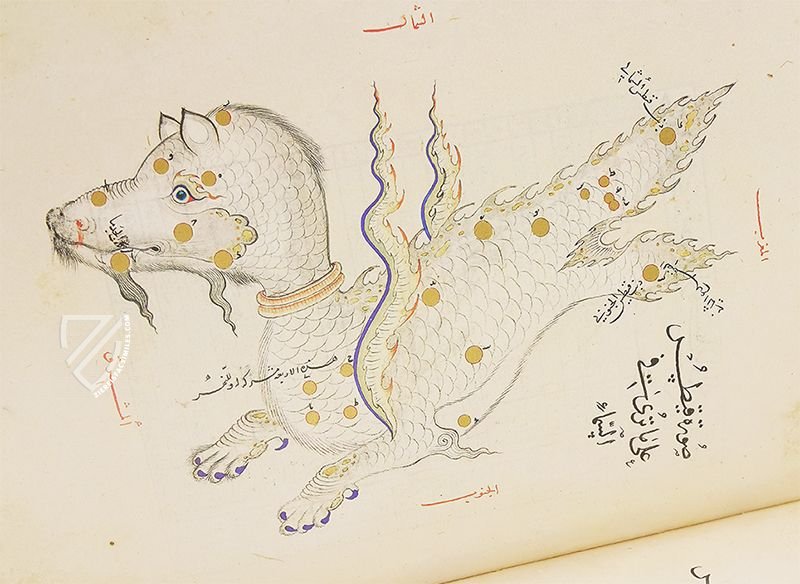
Ulugh Beg's Book of the Constellations
Constellation Al-ꜤadraꜤ.
Al-ꜤadraꜤ, the Virgin, strides north as a young, winged woman conforming to the Chinese ideal of beauty of the time. 26 golden celestial bodies are part of this figure, representing the second largest constellation in the sky, while six external "stars" in red color are grouped in the north, known today as Virgo galaxy clusters.
The impressive and at the same time filigree appearing wings are particularly emphasized by their coloration of blue and red tones against the light robe and the pale flesh tone. However, they are not only of aesthetic value, but also solve a problem of representation: without wings, it is hardly possible to artistically integrate the star at the upper left into the figure. Even the brightest and thus largest star of the constellation on the right palm of Virgo is just barely within the figure.
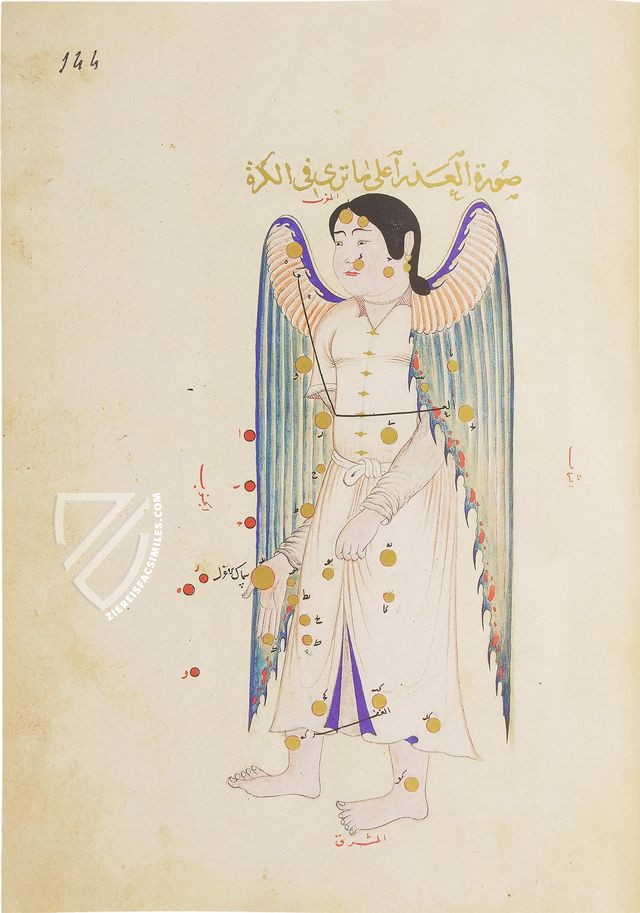
#1 Die Astronomie des Prinzen – Das Buch der Fixsterne (Ulugh Beg)
Language: English, German
(3,000€ - 7,000€)
#2 Die Astronomie des Prinzen – Das Buch der Fixsterne (Ulugh Beg)
Language: English, German
(3,000€ - 7,000€)
- Treatises / Secular Books
- Apocalypses / Beatus
- Astronomy / Astrology
- Bestiaries
- Bibles / Gospels
- Chronicles / History / Law
- Geography / Maps
- Saints' Lives
- Islam / Oriental
- Judaism / Hebrew
- Single Leaf Collections
- Leonardo da Vinci
- Literature / Poetry
- Liturgical Manuscripts
- Medicine / Botany / Alchemy
- Music
- Mythology / Prophecies
- Psalters
- Other Religious Books
- Games / Hunting
- Private Devotion Books
- Other Genres
- Afghanistan
- Armenia
- Austria
- Belgium
- Belize
- Bosnia and Herzegovina
- China
- Colombia
- Costa Rica
- Croatia
- Cyprus
- Czech Republic
- Denmark
- Egypt
- El Salvador
- Ethiopia
- France
- Germany
- Greece
- Guatemala
- Honduras
- Hungary
- India
- Iran
- Iraq
- Israel
- Italy
- Japan
- Jordan
- Kazakhstan
- Kyrgyzstan
- Lebanon
- Liechtenstein
- Luxembourg
- Mexico
- Morocco
- Netherlands
- Palestine
- Panama
- Peru
- Poland
- Portugal
- Romania
- Russia
- Serbia
- Spain
- Sri Lanka
- Sweden
- Switzerland
- Syria
- Tajikistan
- Turkey
- Turkmenistan
- Ukraine
- United Kingdom
- United States
- Uzbekistan
- Vatican City
- A. Oosthoek, van Holkema & Warendorf
- Aboca Museum
- Ajuntament de Valencia
- Akademie Verlag
- Akademische Druck- u. Verlagsanstalt (ADEVA)
- Aldo Ausilio Editore - Bottega d’Erasmo
- Alecto Historical Editions
- Alkuin Verlag
- Almqvist & Wiksell
- Amilcare Pizzi
- Andreas & Andreas Verlagsbuchhandlung
- Archa 90
- Archiv Verlag
- Archivi Edizioni
- Arnold Verlag
- ARS
- Ars Magna
- ArtCodex
- AyN Ediciones
- Azimuth Editions
- Badenia Verlag
- Bärenreiter-Verlag
- Belser Verlag
- Belser Verlag / WK Wertkontor
- Benziger Verlag
- Bernardinum Wydawnictwo
- BiblioGemma
- Biblioteca Apostolica Vaticana (Vaticanstadt, Vaticanstadt)
- Bibliotheca Palatina Faksimile Verlag
- Bibliotheca Rara
- Boydell & Brewer
- Bramante Edizioni
- Bredius Genootschap
- Brepols Publishers
- British Library
- C. Weckesser
- Caixa Catalunya
- Canesi
- CAPSA, Ars Scriptoria
- Caratzas Brothers, Publishers
- Carus Verlag
- Casamassima Libri
- Centrum Cartographie Verlag GmbH
- Chavane Verlag
- Christian Brandstätter Verlag
- Circulo Cientifico
- Club Bibliófilo Versol
- Club du Livre
- CM Editores
- Collegium Graphicum
- Collezione Apocrifa Da Vinci
- Comissão Nacional para as Comemorações dos Descobrimentos Portugueses
- Coron Verlag
- Corvina
- CTHS
- D. S. Brewer
- Damon
- De Agostini/UTET
- De Nederlandsche Boekhandel
- De Schutter
- Deuschle & Stemmle
- Deutscher Verlag für Kunstwissenschaft
- DIAMM
- Droz
- E. Schreiber Graphische Kunstanstalten
- Ediciones Boreal
- Ediciones Grial
- Ediclube
- Edições Inapa
- Edilan
- Editalia
- Edition Deuschle
- Edition Georg Popp
- Edition Leipzig
- Edition Libri Illustri
- Editiones Reales Sitios S. L.
- Éditions de l'Oiseau Lyre
- Editions Medicina Rara
- Editorial Casariego
- Editorial Mintzoa
- Editrice Antenore
- Editrice Velar
- Edizioni Edison
- Egeria, S.L.
- Eikon Editores
- Electa
- Emery Walker Limited
- Enciclopèdia Catalana
- Eos-Verlag
- Ephesus Publishing
- Ernst Battenberg
- Eugrammia Press
- Extraordinary Editions
- Fackelverlag
- Facsimila Art & Edition
- Facsimile Editions Ltd.
- Facsimilia Art & Edition Ebert KG
- Faksimile Verlag
- Feuermann Verlag
- Folger Shakespeare Library
- Franco Cosimo Panini Editore
- Friedrich Wittig Verlag
- Fundación Hullera Vasco-Leonesa
- G. Braziller
- Gabriele Mazzotta Editore
- Gebr. Mann Verlag
- Gesellschaft für graphische Industrie
- Getty Research Institute
- Giovanni Domenico de Rossi
- Giunti Editore
- Graffiti
- Grafica European Center of Fine Arts
- Guido Pressler
- Guillermo Blazquez
- Gustav Kiepenheuer
- H. N. Abrams
- Harrassowitz
- Harvard University Press
- Helikon
- Hendrickson Publishers
- Henning Oppermann
- Herder Verlag
- Hes & De Graaf Publishers
- Hoepli
- Holbein-Verlag
- Houghton Library
- Hugo Schmidt Verlag
- Idion Verlag
- Il Bulino, edizioni d'arte
- ILte
- Imago
- Insel Verlag
- Insel-Verlag Anton Kippenberger
- Instituto de Estudios Altoaragoneses
- Instituto Nacional de Antropología e Historia
- Introligatornia Budnik Jerzy
- Istituto dell'Enciclopedia Italiana - Treccani
- Istituto Ellenico di Studi Bizantini e Postbizantini
- Istituto Geografico De Agostini
- Istituto Poligrafico e Zecca dello Stato
- Italarte Art Establishments
- Jan Thorbecke Verlag
- Johnson Reprint Corporation
- Josef Stocker
- Josef Stocker-Schmid
- Jugoslavija
- Karl W. Hiersemann
- Kasper Straube
- Kaydeda Ediciones
- Kindler Verlag / Coron Verlag
- Kodansha International Ltd.
- Konrad Kölbl Verlag
- Kurt Wolff Verlag
- La Liberia dello Stato
- La Linea Editrice
- La Meta Editore
- Lambert Schneider
- Landeskreditbank Baden-Württemberg
- Leo S. Olschki
- Les Incunables
- Liber Artis
- Library of Congress
- Libreria Musicale Italiana
- Lichtdruck
- Lito Immagine Editore
- Lumen Artis
- Lund Humphries
- M. Moleiro Editor
- Maison des Sciences de l'homme et de la société de Poitiers
- Manuscriptum
- Martinus Nijhoff
- Maruzen-Yushodo Co. Ltd.
- MASA
- Massada Publishers
- McGraw-Hill
- Metropolitan Museum of Art
- Militos
- Millennium Liber
- Müller & Schindler
- Nahar - Stavit
- Nahar and Steimatzky
- National Library of Wales
- Neri Pozza
- Nova Charta
- Oceanum Verlag
- Odeon
- Orbis Mediaevalis
- Orbis Pictus
- Österreichische Staatsdruckerei
- Oxford University Press
- Pageant Books
- Parzellers Buchverlag
- Patrimonio Ediciones
- Pattloch Verlag
- PIAF
- Pieper Verlag
- Plon-Nourrit et cie
- Poligrafiche Bolis
- Presses Universitaires de Strasbourg
- Prestel Verlag
- Princeton University Press
- Prisma Verlag
- Priuli & Verlucca, editori
- Pro Sport Verlag
- Propyläen Verlag
- Pytheas Books
- Quaternio Verlag Luzern
- Reales Sitios
- Recht-Verlag
- Reichert Verlag
- Reichsdruckerei
- Reprint Verlag
- Riehn & Reusch
- Roberto Vattori Editore
- Rosenkilde and Bagger
- Roxburghe Club
- Salerno Editrice
- Saltellus Press
- Sandoz
- Sarajevo Svjetlost
- Schöck ArtPrint Kft.
- Schulsinger Brothers
- Scolar Press
- Scrinium
- Scripta Maneant
- Scriptorium
- Shazar
- Siloé, arte y bibliofilia
- SISMEL - Edizioni del Galluzzo
- Sociedad Mexicana de Antropología
- Société des Bibliophiles & Iconophiles de Belgique
- Soncin Publishing
- Sorli Ediciones
- Stainer and Bell
- Studer
- Styria Verlag
- Sumptibus Pragopress
- Szegedi Tudomànyegyetem
- Taberna Libraria
- Tarshish Books
- Taschen
- Tempus Libri
- Testimonio Compañía Editorial
- Thames and Hudson
- The Clear Vue Publishing Partnership Limited
- The Facsimile Codex
- The Folio Society
- The Marquess of Normanby
- The Richard III and Yorkist History Trust
- Tip.Le.Co
- TouchArt
- TREC Publishing House
- TRI Publishing Co.
- Trident Editore
- Tuliba Collection
- Typis Regiae Officinae Polygraphicae
- Union Verlag Berlin
- Universidad de Granada
- University of California Press
- University of Chicago Press
- Urs Graf
- Vallecchi
- Van Wijnen
- VCH, Acta Humaniora
- VDI Verlag
- VEB Deutscher Verlag für Musik
- Verlag Anton Pustet / Andreas Verlag
- Verlag Bibliophile Drucke Josef Stocker
- Verlag der Münchner Drucke
- Verlag für Regionalgeschichte
- Verlag Styria
- Vicent Garcia Editores
- W. Turnowski Ltd.
- W. Turnowsky
- Waanders Printers
- Wiener Mechitharisten-Congregation (Wien, Österreich)
- Wissenschaftliche Buchgesellschaft
- Wissenschaftliche Verlagsgesellschaft
- Wydawnictwo Dolnoslaskie
- Xuntanza Editorial
- Zakład Narodowy
- Zollikofer AG

